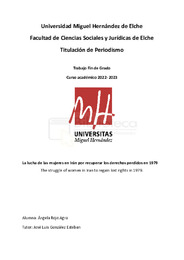Please use this identifier to cite or link to this item:
https://hdl.handle.net/11000/30238La lucha de las mujeres en Irán por recuperar los derechos perdidos en 1979
| Title: La lucha de las mujeres en Irán por recuperar los derechos perdidos en 1979 |
| Authors: Rojo Agra, Ángela |
| Tutor: González-Esteban, José Luis |
| Editor: Universidad Miguel Hernández de Elche |
| Department: Departamentos de la UMH::Ciencias Sociales y Humanas |
| Issue Date: 2023-06 |
| URI: https://hdl.handle.net/11000/30238 |
| Abstract: Hasta 1979, el Sha de Irán gobernaba un país emergente muy rico en petróleo y bastante industrializado. Esta independencia económica y tecnológica hizo que las grandes potencias mundiales apoyasen un movimiento de disidencia contra el régimen del momento. El levantamiento era debido al descontento social que residía en el país causado por la gestión política y económica por parte del Sha. La rebelión del país tenía como máximo representante a Jomeini y las diferencias sociales entre la población rural y la urbana favorecieron el cambio. Jomeini, rápidamente creó una dictadura teocrática que atenta contra las libertades de los ciudadanos. Desde el año 1980, las mujeres se empezaron a manifestar en contra del régimen porque implantó la necesidad de reconocer la autoridad masculina. Fueron las primeras manifestaciones en contra del régimen, pero estas fueron duramente reprimidas. Lo que sucedió fue lo que provocó el levantamiento que lleva 44 años propagándose. En la actualidad, el movimiento ha estallado por el suceso del 13 de septiembre de 2022, cuando la jóven Mahsa Amini fue detenida por la ‘policía de la moral’ y tras varios golpes por parte de estos fue trasladada a un hospital donde murió el 16 de septiembre de 2022. La rabia e indignación que sentía la población y la situación económica y política del país hizo que salieran a la calle a protestar. Pero, se han encontrado con una represión muy fuerte, más de 500 muertos y más de 20.000 personas detenidas. La República Islámica de Irán se ha consolidado mediante leyes y reglamentos de discriminación a la mujer, sobre todo en cuatro áreas relevantes: El matrimonio y el divorcio, la custodia, la herencia y el ámbito laboral, social y económico. La sociedad iraní busca la igualdad de género en las áreas mencionadas, ya que para ellos es esencial y aseguran que cualquier diferencia o relevancia del hombre ante la mujer en estos aspectos debe de ser sancionada. Until 1979, the Shah of Iran ruled an enormously oil-rich and highly industrialized emerging country. This economic and technological independence made the great Powers of the world support a dissident movement against the regime at that time. The uprising was due to the social unrest lying in the country, caused mainly by the Shah’s economic and political mismanagement. Social differences between the rural and urban populations triggered change in the country where Khomeini was the highest representative of the rebellion. He quickly established a theocratic dictatorship that undermined citizens’ freedoms. In 1980, women started to take part in demonstrations against a regime which established male supremacy. Those first protesters were harshly repressed. However, they led a revolution that has been spreading for 44 years. Events such as the one which took place on 13 September 2022 have rekindled the flame. That day, young Mahsa Amini was arrested and brutally beaten by the so-called “morality police”. Then, she was taken to hospital where she eventually died on 16 September 2022. The incident triggered angry protests and unleashed huge rage and indignation among a population who was already fed up with the deterioration of Iran’s economic and political situation. However, protesters were severely repressed. More than 500 people were killed, many of them were women; more than 20.000 people were arrested, most of them were students. The Islamic Republic of Iran has consolidated its discrimination against women policy by creating and enforcing discriminatory laws and regulations in four key areas: marriage and divorce, child custody, inheritance, and labour, social and economic issues. Iranian society is yearning for gender equality in the aforesaid fields. They not only claim that it is essential but also that the slightest difference or pre-eminence of man over woman at any of these aspects must be punished. |
| Keywords/Subjects: Discriminación mujer República Islámica movimientos de disidencia libertad represión discrimination against women freedom repression dissident movement |
| Knowledge area: CDU: Generalidades.: Periódicos. Prensa. Periodismo. Ciencias de la información |
| Type of document: application/pdf |
| Access rights: info:eu-repo/semantics/openAccess Attribution-NonCommercial-NoDerivatives 4.0 Internacional |
| Appears in Collections: TFG- Periodismo |
.png)

